
THE CASE FOR LEO VS. AUSTIN
Even by today’s standards – when 107,000 plus people turn out to watch Michigan play Ohio State on a routine Saturday or 80,000 people attend the Super Bowl, a crowd of 120,000 for a football game is impressive. Add to it the fact it was a high school game — Leo versus Austin in 1937 – that drew such a crowd and it makes it even more remarkable.
The 1937 game was the then Chicago Mayor’s Charity Game, known as the Kelly Bowl, an event in it’s forth year which pitted the champion of the Chicago Catholic League against the champion of the Chicago Public League. The attendance at the game, according to the USA Today ranking and other sources, stands as the largest crowd ever for an American Football game – prep or otherwise. The attendance even exceed the attendance at the largest American Professional Football game ever held, the American Bowl between the Dallas Cowboys and the Houston Oilers held on Aug. 15, 1994, in Mexico City where attendance stood at 112,336.
Beside the fact that this was the gridiron equivalent of a civil war, a series of factors came together to generate the enormous interest in, and attendance at, the 1937 Chicago City High School Championship game. These factors combined to create an event at the right time, in the right place, with the right teams – and star players — and with the right drama to create an event of historic proportions.
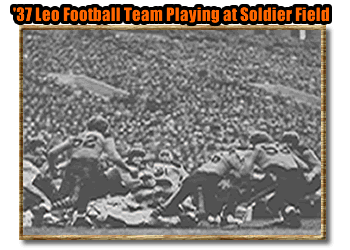 Click to Enlarge
Click to Enlarge
In 1937 Chicago, high school football was big. Chicago newspapers regularly covered prep football as a large front page story. College football was burgeoning in popularity and it was supported by a boom in the building of of large capacity stadiums, and even greater coverage in the press. However, the most well-attended games in the nation remained high school championship games between Public and Catholic schools in Chicago and Philadelphia, along with prep charity events. The Leo-Austin matchup was both.
Attendance at the NFL Championship game did not reach 50,000 until 1946 and didn’t consistently top that mark until after 1951. Only 15,870 fans saw the Washington Redskins beat the Chicago Bears 28-21 in the 1937 NFL Championship game played in Chicago’s Wrigley Field.
Leo and Austin had more going for it than the Wrigley Field Stadium the Chicago Bears used at the time, with its 47,000 seat capacity with the addition of temporary stands. The prep champs had Soldier Field, the lakefront stadium that opened in 1924 as the Grant Park Municipal Stadium, an architectural wonder modeled after the Parthenon that occupied more than seven acres of landfill. It was built in neoclassical style with large Doric colonnades along each side. The building had exterior dimensions of 1,184 feet by 678 feet and an infield that measured 887 by 300 feet. A true amphitheater, the stadium was built to host all manner of public events geared toward large crowds.
Soldier Field’s first event was an athletic competition among police officers, which was reported to have drawn 90,000 spectators. From then on, crowds in excess of 100,000 were common, with attendance of 150,000 possible when the infield could be used as well as the stands. Renovations since 1954 have reduced the permanent seating capacity at Soldier Field to 61,500 in the name of greater intimacy for the fans.
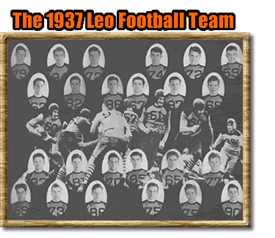 Click to Enlarge
Click to Enlarge
A crowd of 120,000 was not out of the question in 1937, when South Side Leo and West Side Austin squared off for at least bragging rights in a city that prided itself on its neighborhoods built on ethnicity and religion and the ability to raise funds for needy children. A report in the Chicago Tribune Nov, 27, 1987, the 50th anniversary of the game, said the game raised some $100,000 for the City’s “Christmas Fund,” used to clothe needy kids.
The game was promoted, in part, by “flooding” the city with tickets. According to the Tribune, tickets cost 50 cents to $1, not only a bargain compared to the $2.50 to see the Bears but almost a civic duty considering they were available at all fire stations with firefighters actively selling them. The game, it should be noted, also was broadcast on WBBM radio.
Another draw for the game, was the chance to see Austin star running back Bill DeCorrevont and his Leo counterpart Johnny Galvin, which helped spread interest all the way to New York, with the Times covering the game.
“The size of the crowd amazed even the most enthusiastic sponsors of the game. The ballyhooing of DeCorrevont attracted thousands of football fans. The rivalry of public and Catholic high schools lured thousands of others.” The Times report on Nov. 28, 1937, added that DeCorrevont didn’t disappoint, accounting for four touchdowns “despite a game leg” in Austin’s 26-0 win.
Mayor Edward J. Kelly, for whom the game was named, was a strong New Deal Democrat and a Catholic, but a product of the Chicago Public Schools, which he attended until 5th grade when he went to work to help support his family, according to a story in the Chicago Reader Jan. 6, 2015. He presided over the city during the Great Depression. And though his tenure was scarred by organized crime, gambling and scandal, it ended in 1947 largely over his integrationist views, in a city experiencing the pressure of a Great Migration of African-Americans from the South, whose numbers ultimately grew to 1 million by 1970.
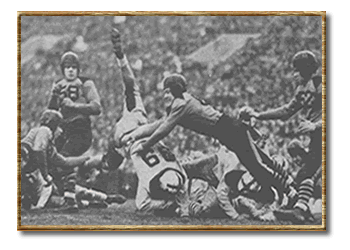 Click to Enlarge
Click to Enlarge
Still billing itself as a city of neighborhoods, Chicago was much more so in the 1930s. With entertainment options limited to local pursuits thanks to cumbersome transportation options including street car, the “L” or walking, people focused on the events in their neighborhood. In its 50th anniversary story on the Big Game, the Tribune pointed out residents near Leo could see “Broadway Melody of 1938” and “Something to Sing About” at the Southtown Theatre. And those near Austin could see a double bill of “100 Men and a Girl” and “Dead End” at State Theater.
Austin High, in the Austin neighborhood, was about 15 miles from Leo in Auburn-Gresham, a substantial physical and philosophical distance in 1937. Austin was in an area that had a considerable ethnic mix, a white ethnic mix, but a mix. The neighborhood was populated in large part by individuals of German, Scandinavian, Irish, Italian and Greek heritage. Whether new arrivals or more established in the U.S., they worshiped at the myriad Protestant Churches: Baptist, Christian, Congregational, Episcopal, Methodist, Presbyterian, Unitarian as well as Catholic. This made the Austin High student body diverse in heritage and religious affiliations.
The importance of religion in Chicago was enormous in 1937. Ten years earlier, Mayor William Hale “Big Bill” Thompson had made an issue of the Catholicism of his opponent, William Dever, asserting Dever would cause city government to be dominated by the Pope. The issue was one that still had to be seriously addressed as late as 23 years later, in 1960, when John F. Kennedy ran for president.
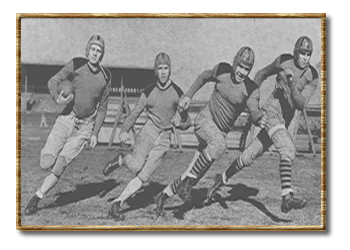 Click to Enlarge
Click to Enlarge
The area immediately surrounding Leo was predominantly Irish and Catholic, reflecting the settlement path of a large group of immigrants who began arriving in the city in the 1860s. The neighborhood even hosted its own St. Patrick’s Day Parade along 79th Street until 1959, according to SouthSideIrishParade.org. Leo was not subject to neighborhood boudaries, but it drew it’s students predominantly from within a five-mile radius of the school, bringing in students from German, Italian and Polish backgrounds.
For 1937 Leo fans, parish life would have dominated their social lives. This increased the divide between Catholics and “Publics” and the stakes of the game. This divide further fueled interest in the game with the Leo players representing the Catholic population of Chicago, as did the other Catholic League teams that played in the city championship. The Austin players, even the Catholics among them, would have symbolically carried the standard for the city’s Protestants and other religions.
THE GAME
Against this backdrop, there was a game. The excitement of seeing a top-notch athletic competition between the two teams is what ultimately brought the fans to the game. The contest itself was somewhat one-sided, but not so much so as to cause Leo fans to lose hope before the final quarter. Austin entered the Kelly Bowl with an undefeated record in Public League play. Leo had only one loss.
Each was powered by their all-star running back who had thrilled crowds and whose heroics boded for a bright future in college or professional play. Bill DeCorrevont was the star for Austin and came into the game having scored 33 touchdowns. John Galvin, the Leo star, had led his team through a string of victories after an initial loss in its first regular season game.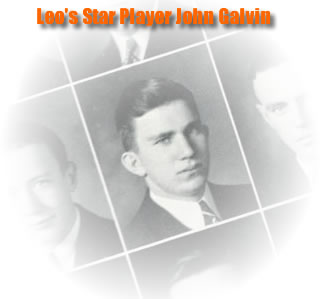
Galvin was not playing at full capacity, a review in the 1938 Leo High School yearbook (available for viewing on our website) discusses his fine play despite being “severely handicapped with a dislocated shoulder.” That was confirmed by his obituary in the Tribune Dec. 27, 1998, which said he had a broken collarbone. Whether this injury affected the outcome of the game is conjecture, as newspaper accounts refer to DeCorrevont as playing with an injured leg.
But the presence of Galvin and DeCorrevont made the game overwhelmingly a running contest. The New York Times account of the game Nov. 28, 1937, bubbled that “DeCorrevont, the most widely publicized schoolboy star in history, scored three touchdowns and passed into the endzone for a fourth one.”
In a scoreless first quarter it looked as if Leo would control the game. Austin, however, scored two touchdowns in the second quarter. Austin failed to convert for the extra point after the second touchdown and ended the first half with a 13-0 lead. At the opening of the second half, Leo displayed renewed ability to move the ball; however Leo’s offense bogged down and Austin added two more touchdowns, one in each of the third and forth quarters, with a point after added in the forth quarter for good measure, for a 26-0 finish.
Austin’s win sent the team to Jackson, Tennessee, to face the Southern United States High School Champions. Austin won that game 13-0 and was thereby able to claim the (then) title of U.S. National High School Football Champions (see the football section of the Austin High School 1938 yearbook available for viewing on our website). It also gave the Public League its third victory in four Kelly Bowls.
Leo fans could find consolation in future years when, after an additional loss in the Kelly Bowl in 1940, Leo went on to win the game in 1941 and 1942 as the leagues became more evenly matched into the 1950s. (The Catholic League began to dominate in the 1960s through the early 1980s, for a variety of reasons which reflected in the comparative quality of the two league’s sports programs at the time. In recent years, the best Catholic and Public League teams opt out of the Prep Bowl to pursue state playoff opportunities, since both leagues joined Illinois State High School Association in the late 1970s.)
For their parts, Galvin went on to break the Big 10 punting average while at Purdue University and was a punter with the Baltimore Colts in 1947 after spending time as a shortstop in the New York Yankees farm system. DeCorrevont led Northwestern University in offense in 1939 and 1940 and was a running back for the Washington Redskins and quarterback for the Detroit Lions and Chicago Cardinals and Bears after serving in the Navy in World War II.
SOLDIER FIELD FEATS
By the time of the Leo-Austin game, Soldier Field had already hosted a considerable number of well attended football games, including the 1926 Army-Navy game before an estimated 110,000 and nearly 120,000 for the 1927 Notre Dame-University of Southern California game. An similarly large crowd reportedly showed up for the 1928 game between Notre Dame and Navy in Soldier Field.
Even at the time, the Leo-Austin game was considered the most well attended football game. In 2001, USA Today confirmed that it indeed remained to most well attended football game in the U.S.
As for how Soldier field accommodated more than 120,000 fans for a game in 1937, the stadium had 76,000 permanent bleacher seats and had room for and additional 30,000 temporary bleacher seats. These were not in use for the Leo-Austin game; instead, adults and children were packed into the stands, aisles and in lines approximately seven people deep around the stadium’s upper perimeter, according to the Chicago Tribune Nov. 28, 1937.
The story tells of ushers, on the order of chief Andy Frain, opening gates leading to the playing field, and thousands of spectators milling on the track that held midget car races. “I thought they were eight to 10 rows deep every place I looked,” DeCorrevont said at the time.
The best place to watch on the sideline was a knoll where the north stands once stood. It was estimated that part of the crowd was “ten thousand,” according to the Tribune report. And DeCorrevont recalls people telling him there were hundreds of nonpaying fans watching from the Park District administration building on 14th Street. “I don`t know what they could see from there,” DeCorrevont told the Tribune. “They must have been two blocks from the game.”
It should be noted that the largest crowd ever recorded to have used the Soldier Field was 260,000 for the 1954 Marian Year Tribute held by the Catholic Church, a religious event to honor and venerate the Virgin Mary during a year dedicated for that purpose by the Church. Of the 260,000, however, approximately 100,000 people gathered outside the stadium to hear the service through loudspeakers.
About Leo Alumni
Starting from the individuals, predominantly Irish Catholics, who attended Leo at the time of the Big Game, the Leo Alumni have become a more diverse group, reflecting the change in the student population as the neighborhood around the school has become predominantly African-American.
For all Leo Alumni, involvement in the game with the largest fan attendance in history is part of the proud and storied history of Leo High School, Austin High School and the Chicago Catholic and Public Leagues. This history is made daily at Leo and greatly assisted by alumni support of the school. We hope you have enjoyed our Big Game history. Your comments, feedback, suggestions, editing and/or other help is hereby solicited. You can contact us through our e-mail or our blog. If we use your editing in a noticeable way, we will post your name as a contributor for a period of not less than one year.
— Thomas W. Lynch ’73 with the assistance of and on behalf of Leo High School and The Leo High School Alumni Association 08/21/07
NOTE: The sources below document the story told by this article, particularly in that they substantiate the most important assertions made in the article. Additional sources for statements less important to the theme of the article or which duplicate authoritative sources cited here are available and can be provided upon request.
BIBLIOGRAPHY
The Official Website of the FedEx Orange Bowl
NFL Internet Network “Superbowl Recaps”
Official Website of the National Football League
The Chicago Tribune, November 28, 1937
The Southtown Economist, November 28, 1937
Encyclopedia of Chicago, see the Kelly-Nash Machine; Machine Politics; Soldier Field entry; and Football entries
King Football, Sport and Spectacle in the Golden Age of Radio and Newsreels, Movies and Magazines, The Weekly & The Daily Press by Michael Orradi, 2001 The University of North Carolina Press, Chapel Hill and London
NFL Championship Games Results 1933 to 1969
Stadiums of Pro Football Past
Time Magazine, Sept. 20, 1954
Wikipedia, The Free Encyclopedia, Soldier Field
The University of Illinois at Chicago, “Political History of Bridgeport
Roosevelt University On-Line, www.roosevelt.edu/chicagohistory/mod3-chap1.htm
The Leo High School Yearbook, 1938
The Austin High School Yearbook, Sports Section, Football, 1938
The Chicago Tribune, ”Schools of Hard Knocks,” by Barry Temkin
And other sources
Largest crowd to see football game betweenAustin High School and Leo.
The 2nd largest crowd ever to see a high school football game occurred at the Cleveland Charity Game in 1946. The Cathedral Latin Lions defeated The Holy Name Green Wave 35-6. The crowd was 70,955 and took place at Cleveland Municipal Stadium. The Lions were State Champions that year and beat Massillon 14-7.
I believe the 2nd largest crowd ever to see a high school football game took place in Cleveland at the old Municipal Stadium in the City Championship Game known as the Charity Game. The Cathedral Latin Lions defeated the Holy Name Green Wave 35-6. The crowd was 70,955.
Gordon McKenzie, a member of the Austin team went on to play at the University of Illinois. He was my high school coach at Watseka Il. He is a member of the IHSA sports hall of fame. He was one of the most successful coaches in IHSA history. In addition he was a mentor to his players outside of the football area. Fair play and doing the “right thing” was instilled in all his players. At his induction in the HOF he stated “This award goes to the 400+ young men who played on my teams